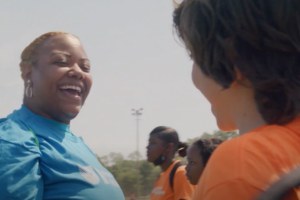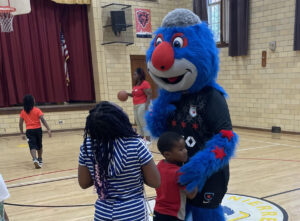I once had a professor who noted the underestimated connection between motion and emotion. During my seasons with Urban Initiatives, that connection has asserted itself time and time again.
When walking, sitting, or standing still (the “slow” motions), it is easy to stay inside an insulated psychological shell. Any mental confrontation with the outside world can be dealt with the same way the slow-motioner deals with a physical confrontation with the outside world: look away, close your eyes, hold your breath. There is no strong need to interact with the outside world or with others, mentally or physically, when you slow-motion through the day.
When sprinting, breathing hard, trying to win as a team, and confronting boundaries to physical movements (in soccer, “fouls”), the fast-motioner has no option but to interact with the real world, with team members, and with people in positions of authority.
That’s where I come in. I volunteer for Urban Initiatives as a referee. I’m also a law student. As such, I take very seriously my position as a role model of even-handed justice. I enforce the rules of the game equally, and allow maximum liberty within those boundaries.
I have seen kids realize, through an afternoon of reinforcement, that it’s okay to be themselves and to test their outer limits: to sprint as fast as they can, to kick the ball as hard as they can, to scream as loud as they can (say, when they miss or make a goal). Those superlatives all fall within the rules of the sport, whereas each one is at least on the perimeter of the acceptable in the rest of the life of a young person. When else can a kid scream as loud as they can without anyone telling them to “keep it down,” or asking them what is wrong? And when they look at me after they do to see if I’m going to punish them or another player, they typically get a nice big smile. No rule violation, no whistle, no reason to be anything but happy.
Sports like soccer also allow students to test the outer limits of their creativity within very specific guidelines. For example, in soccer, the offside rule is very clear. Outside of the requirement that a player be onside, though, a team can pass the ball wherever and however they want. The walls at the indoor center on Pershing facilitate even more creative possibilities. When someone breaks the rules, I blow the whistle and clearly tell everyone what foul was committed so we’re all working with the same rules. Because they are fast-motioning, the players interact with the rules and with me as an authority figure.
After the games, we sometimes talk about lessons of the day or have other health and wellness activities. Here again, the fast-motion of the game extends to the slow-motion of the quasi-classroom. Students are quick to volunteer correct answers the same way they were quick to race toward a ball. Students feel free to say the first thing that comes to their mind. As long as they raise their hand and wait to be called upon, they can say what they want, and I try my hardest to make each answer-giving instance a positive experience for the speaker and the listeners.
The hardest part of coaching and, I’m sure for the kids, playing, is when someone breaks a serious social rule. At this point, my role switches from soccer referee to social referee. Just like soccer, students are completely free within the social rules. Once a rule is broken, though, I blow the whistle. A typical example is a child calling another child a bad name that they may not realize is deeply hurtful. Because these situations are more delicate and usually only arise in the passion of a fast-motioner’s mind, I gather everyone together and talk through the foundations of what a person has said. It is easy to understand why a soccer rule is a rule: that’s what the sport’s governing body has written. It is less easy to understand why a social rule is a rule, so those situations require a little bit more teaching.
This is precisely where I place the importance of Urban Initiatives. The students are all fast-motioners by this point: their hearts are beating quickly, they are breathing hard, and they are interacting with the outside world on a very high level. When I ask question like, “Why is it bad to call someone a [ ]?” or “How did it make you feel when she said [ ]?”, the students are quick to respond openly and fully. The shy, closed up student is gone, and the interactions between all students—in the secure presence of an even-handed adjudicator—flourish.



